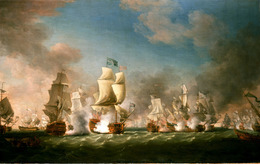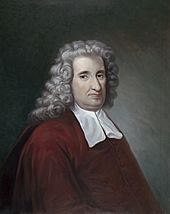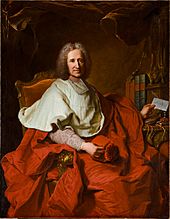Treaty of The Hague (1720) facts for kids

The Battle of Cape Passaro, 11 August 1718
|
|
| Context | Philip V and Emperor Charles VI confirm terms of Treaty of Utrecht Spain renounces claims to its former Italian possessions Savoy and Austria swap Sicily for Sardinia; Charles of Spain made heir to the Duchies of Parma and Tuscany |
|---|---|
| Signed | 17 February 1720 |
| Location | The Hague |
| Effective | 20 May 1720 |
| Negotiators | |
| Parties | |
| Language | Neo-Latin |
The 1720 Treaty of The Hague was an important agreement signed on February 17, 1720. It was made between Spain and a group of powerful countries called the Quadruple Alliance. This alliance included Britain, France, the Dutch Republic (now the Netherlands), and Austria.
By signing this treaty, Spain officially joined the Alliance. This action helped end the War of the Quadruple Alliance. Spain also agreed to the rules set out in the 1718 Treaty of London.
One key part of the agreement was about the Spanish throne. As decided earlier in the Treaty of Utrecht in 1713, King Philip V of Spain gave up any claim to the French throne. He also gave up Spain's claims to its former lands in Italy.
In return, Emperor Charles VI of Austria gave up his claim to the Spanish throne. Also, Charles of Spain, who was only four years old at the time, was recognized as the future ruler of the Duchies of Parma and Tuscany in Italy.
Another important part of the treaty was an exchange of islands. The Duchy of Savoy and Austria swapped Sicily for Sardinia.
Contents
Why the Treaty Was Needed

The War of the Spanish Succession ended in 1714 with the Treaty of Utrecht. A main rule of this treaty was that France, Austria, and Spain should never be ruled by the same person. This was to keep any one country from becoming too powerful.
Philip V, who was the grandson of French King Louis XIV, became the first Bourbon king of Spain. But Spain had to give up many lands. These included Naples, Sicily, Milan, and the Southern Netherlands to Austria. Spain also gave Sardinia to the Duchy of Savoy. Britain kept Gibraltar and Menorca.
King Philip V wanted to get these lands back. He felt it was important for Spain's honor. So, his new main advisor, Cardinal Giulio Alberoni, made this his top goal. Alberoni was from Parma in Italy.
In 1714, Alberoni helped arrange the marriage of King Philip to Elisabeth Farnese. She was the niece of the Duke of Parma. Elisabeth also wanted to get Italian lands back. King Philip had two sons from his first marriage. She wanted to make sure her own children would inherit lands in Italy.
Trouble After King Louis XIV Died
When King Louis XIV died in 1715, his great-grandson, Louis XV, became king. Louis XV was only five years old. If he died, the next in line for the French throne was Philip V of Spain. This made people worry about the rule from the Treaty of Utrecht.
Also, Emperor Charles VI of Austria had been a candidate for the Spanish throne. He became Holy Roman Emperor in 1711. But he still refused to officially give up his claim to the Spanish throne.
The Duke of Orléans was ruling France while Louis XV was a child. He needed peace to help France's economy recover. This meant making sure the Utrecht treaty rules were followed. To do this, he needed Britain's help. This led to the alliance between Britain and France in 1716.

Austria had been slow to set up the "Dutch Barrier." This was a defense system that the Dutch Republic had spent a lot of money on. In January 1717, the Dutch Republic joined France and Britain. They formed the Triple Alliance. This alliance repeated the rules of the Utrecht treaty. It also agreed that Savoy and Austria would trade Sicily and Sardinia.
Cardinal Alberoni thought that Britain and France would not fight over these islands. Austria was busy fighting the Ottoman Empire from 1716 to 1718. So, Spain took over Sardinia without a fight in 1717. In early 1718, Spain started getting ready to attack Sicily.
Sicily was very important for British trade. In June, a British navy fleet led by Admiral Byng arrived in the Western Mediterranean. This was meant to stop Spain from attacking.
The War of the Quadruple Alliance Begins
To stop the fighting from getting worse, British leader Earl Stanhope and French Foreign Minister Guillaume Dubois offered King Philip the Italian lands of Parma and Tuscany. However, Philip said no.
Spanish forces landed on Sicily in early July. In response, Britain and France signed the Treaty of London on July 18. This treaty set out their ideas for ending the conflicts. They invited Austria, Spain, and Savoy to join. Austria joined the Alliance on August 2, after signing a peace treaty with the Ottoman Empire.
Even though Admiral Byng's ships destroyed the Spanish fleet at the Battle of Cape Passaro on August 11, Philip still hoped to keep control of Sicily. This was because there were disagreements within the Alliance. The Dutch Republic did not want to join the war. Many French leaders preferred to be allies with Philip rather than Britain. Spain also gave special trade rights to French merchants. They even hired French ships to bring supplies to their forces in Sicily.
However, in December 1718, a Spanish-backed plan was discovered. This was the Cellamare conspiracy, which aimed to replace the Duke of Orléans as Regent of France. This discovery allowed Orléans to say that his actions were against Alberoni, not King Philip. So, France declared war on Spain on January 2, 1719.
Austrian forces in Sicily had some wins and some losses. But without control of the sea, Spain's defeat was sure to happen. Spain tried to distract Britain by supporting the Jacobite Rising in 1719, but it failed. The Capture of Vigo in October showed how easily the Royal Navy could attack the Spanish coast. King Philip fired Alberoni in December 1719 and agreed to end the war.
What the Treaty Said
There wasn't much new discussion about the terms. By joining the Quadruple Alliance on February 17, 1720, Spain simply agreed to the rules that France, Britain, the Dutch Republic, and Austria had already set on August 2, 1718.
These rules included:
- Neither France nor Austria could be united with Spain under one ruler.
- Savoy and Austria would exchange the islands of Sicily and Sardinia.
- King Philip's third son, Charles of Spain, would become the future ruler of Parma, Piacenza, and Tuscany.
What Happened Next
The treaty did not fully stop worries about changes to the Utrecht agreement. For example, the 1721 Treaty of Madrid was a defense agreement between France, Spain, and Britain. The British king, George I, agreed to discuss returning Gibraltar in Parliament "at a favorable opportunity." Spain saw this as a promise to give Gibraltar back.
However, trade problems between Britain and Spain continued. The lack of progress on Gibraltar led to a new war between Britain and Spain in 1727.
Images for kids
See also
 In Spanish: Tratado de La Haya (1720) para niños
In Spanish: Tratado de La Haya (1720) para niños


